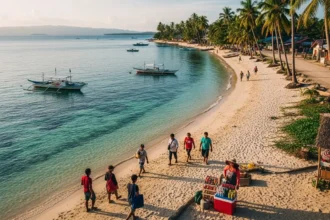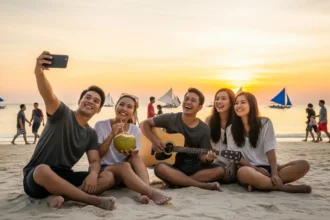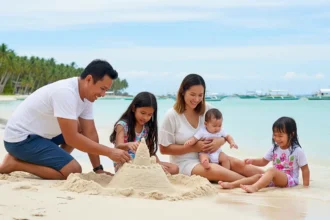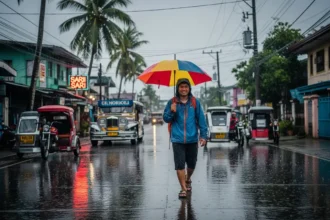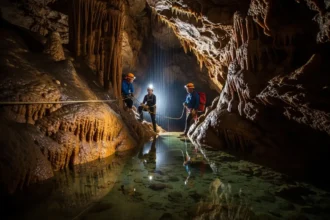If there’s a region in the Philippines that feels like a living postcard, it’s the Visayas. This cluster of islands in the heart of the archipelago is where nature, food, and culture intersect so seamlessly that you can’t separate one from the other. Many travelers first hear about Visayas because of Boracay’s famous white sand, but once they arrive, they discover so much more: centuries-old churches, seafood fresh from the day’s catch, and some of the most spirited festivals in Asia.
For Filipinos, the Visayas also represents family vacations, balikbayan reunions, and once-in-a-lifetime fiestas. For foreigners, it’s often the place that shifts their image of the Philippines from just a tropical escape to a country with rich stories. This Visayas Travel Guide for 2025 is more than sightseeing – it’s an immersion into the country’s soul.
🏖 Beaches You Can’t Miss in the Visayas
The Visayas island group is the heart of the Philippine archipelago, boasting some of the world’s most stunning and diverse beaches. Each island has its own distinct personality, offering a unique slice of paradise. While Boracay has long been the celebrated crown jewel, other islands have been quietly captivating travelers with their pristine beauty and authentic local charm.
Boracay (Aklan): The Vibrant Superstar
Boracay is the undisputed icon of Philippine beaches, and for good reason. Its world-famous White Beach is a breathtaking four-kilometer stretch of sand so fine and white it feels like powdered sugar. The water is a calm, crystal-clear turquoise, perfect for swimming and paddleboarding. Boracay is the ideal destination for travelers who want the best of both worlds: ultimate relaxation by day and a buzzing, energetic nightlife after the sun sets. From luxurious five-star resorts to lively beachfront bars and world-class restaurants, the island offers a polished, high-energy vacation experience that caters to those who love to socialize and celebrate.
Bantayan Island (Cebu): The Serene Escape
For those seeking tranquility, Bantayan Island is a postcard-perfect escape. Located off the northern coast of Cebu, it is known for its quiet charm and long, unspoiled stretches of powdery white sand, particularly at Kota Beach and Paradise Beach. The atmosphere here is laid-back and unpretentious, a world away from the commercial hustle of more famous destinations. It’s the perfect place to rent a scooter and explore sleepy fishing villages, discover hidden coves, and simply read a book under a palm tree. Bantayan is for the traveler who wants to disconnect, unwind, and enjoy the simple, profound beauty of a pristine tropical island.
Malapascua (Cebu): The Diver’s Dream
Another gem north of Cebu, Malapascua has earned a global reputation as a premier diving destination. While its beaches are beautiful and serene, the real magic lies beneath the waves. The island is one of the few places on Earth where you can reliably dive with the magnificent and elusive thresher sharks at Monad Shoal. The diving community here is passionate and dedicated, attracting underwater enthusiasts from all over the world. Malapascua offers a rustic, intimate island experience, where days are spent exploring vibrant coral gardens and nights are for sharing dive stories with fellow travelers at a quiet beachfront bar.
Siquijor: The Mystical Sanctuary
Known as the “Mystical Island,” Siquijor offers a unique blend of natural beauty and enchanting folklore. Its beaches, like Paliton Beach (often called the “Little Boracay”), are stunningly beautiful but see far fewer crowds, giving them a serene and almost spiritual quality. Beyond the sand, the island invites exploration of its inland treasures, from the turquoise waters of Cambugahay Falls to ancient balete trees and local healers. Siquijor is for the adventurous and curious traveler who is drawn to places with a deep story and a touch of magic, offering a peaceful retreat from the modern world.
Kalanggaman Island (Leyte): The Picture-Perfect Sandbar
Kalanggaman Island is the definition of a tropical daydream. It is not an island for resorts or nightlife; it is a raw, uninhabited slice of paradise famous for its spectacular, impossibly long sandbar that stretches far out into the turquoise sea. During high tide, parts of the sandbar disappear, creating a magical and ever-changing landscape. A day trip here is all about pure, simple bliss: swimming in the crystal-clear waters, having a picnic on the sand, and taking photos that look like they came straight from a travel magazine. It’s a must-visit for anyone who wants to experience the raw, untouched beauty of a remote Philippine island.
From the Ground: A Traveler’s Note
The true magic of the Visayas often lies beyond the scenery. When I visited Bantayan Island, I met a tricycle driver who, with a proud smile, told me, “Dito sa amin, hindi lang dagat ang malinis – pati hangin, pati tao.” (Here in our place, it’s not just the sea that is clean-so is the air, and so are the people.)
He was right. The island’s enduring charm wasn’t just in the sand and the sea, but in the genuine warmth of the community. It’s a powerful reminder that when you travel through these islands, you are a guest in someone’s home. The smiles, the stories, and the kindness of the local people are as much a part of the destination as the beaches themselves.
🍽️ A Feast for Every Palate
Food in the Visayas is a journey in itself. Each province has its own specialties that both Filipinos and foreigners rave about, and every meal reflects the region’s deep history and culinary pride. Expect generous portions, bold flavors, and recipes often rooted in centuries-old traditions passed down through families and communities.
Lechon Cebu (Cebu) – Crispy, juicy, and flavorful roasted pig, often hailed as the best in the Philippines. No sauces needed-the seasoning and slow-roasting process give it all the flavor it needs.
La Paz Batchoy (Iloilo) – A comforting noodle soup made with pork innards, miki noodles, crushed chicharon, and a rich broth. It’s best enjoyed piping hot in the bustling La Paz market, where it originated.
Binagol (Leyte) – A sweet delicacy made from taro (locally called gabi), coconut milk, and nuts, wrapped and steamed in a coconut shell. It’s both a snack and a piece of Leyte’s cultural identity.
Silog Meals (Negros Occidental) – Affordable, filling, and loved by locals: silog combinations pair garlic rice and egg with tapa, longganisa, or bangus. Negros is especially known for its flavorful longganisa, often seasoned with vinegar and garlic.
Sutukil (Cebu) – Short for sugba, tula, kilaw (grill, stew, raw marinated fish), this seafood tradition lets you enjoy freshly caught fish and shellfish cooked three different ways. Often found in seaside eateries where the catch is cooked right in front of you.
Chicken Inasal (Bacolod, Negros Occidental) – A smoky, tangy grilled chicken marinated in calamansi, vinegar, lemongrass, and annatto oil. Bacolod’s version is so iconic that the city celebrates “Inasal Festival” and even has an entire Manokan Country lined with inasal stalls.
Tamalos (Samar) – A unique heirloom dish of pork and peanuts wrapped in banana leaves, steamed until thick and savory. Inspired by Mexican tamales during the galleon trade, it has since evolved into a purely Waray delicacy.
Pintados Cassava Cake (Leyte & Samar) – Made with grated cassava, coconut milk, and sugar, this sweet and sticky treat is often served during town fiestas and family gatherings.
Moron (Leyte) – A chocolate-flavored suman (sticky rice cake) cooked in coconut milk and wrapped in banana leaves. Rich, slightly chewy, and often paired with coffee, it’s a beloved pasalubong.
Budbud Kabog (Dumaguete, Negros Oriental) – A rare delicacy made from millet seeds (kabog), coconut milk, and sugar, wrapped in banana leaves. Light, fluffy, and distinct from other rice-based kakanin, it showcases local ingenuity.
Meals in the Visayas aren’t just about taste-they’re about togetherness. Food is always shared, whether it’s a family-style meal at home or a town-wide fiesta where everyone is welcome at the table. Eating here connects you to the spirit of the community as much as to its flavors, so when you sit down for lechon, batchoy, inasal, or tamalos, you’re not just tasting food-you’re joining in a cultural tradition that makes dining in the Visayas unforgettable.
🎭 Festivals that Define the Visayas
Festivals are the heartbeat of the Visayas, blending religion, history, and joy into one massive street party. These fiestas often attract millions of visitors, both local and international, and are among the most colorful celebrations in all of Asia.
Sinulog (Cebu) – Held every January, Sinulog honors the Sto. Niño (Child Jesus) with street dances, grand parades, and religious processions. Participants wear vibrant costumes and perform the famous two-step “Sinulog dance,” symbolizing prayer and thanksgiving. It’s one of the biggest festivals in the Philippines, turning Cebu City into a week-long carnival of faith and revelry.
Dinagyang (Iloilo) – Famous for its high-energy street performances, powerful drumbeats, and elaborate tribal costumes, Dinagyang is a true showcase of Ilonggo pride. Entire communities and schools compete with choreography that combines devotion with artistry, making it not just a festival but a cultural competition on a massive scale.
Ati-Atihan (Aklan) – Known as the “Mother of All Philippine Festivals,” Ati-Atihan celebrates both the Sto. Niño and the indigenous Ati people of Panay. Participants paint their faces and bodies black with soot, dance to hypnotic drumbeats, and chant “Hala Bira!” in honor of their heritage. It’s raw, primal, and deeply spiritual-part street party, part religious pilgrimage.
MassKara Festival (Bacolod, Negros Occidental) – Born out of economic hardship in the 1980s, MassKara features dancers in smiling masks and colorful costumes. The festival symbolizes Bacolod’s resilience, reminding everyone that even in difficult times, the “City of Smiles” continues to celebrate life with optimism and joy.
Pintados-Kasadyaan Festival (Tacloban, Leyte) – A vibrant celebration that showcases the warrior traditions of the ancient Visayans. “Pintados” refers to the tattooed warriors of old, and performers today paint their bodies in elaborate designs to honor this heritage. The festival combines religious devotion to the Sto. Niño with historical pride, making it one of Leyte’s most spectacular events.
Sandugo Festival (Bohol) – Held every July, Sandugo commemorates the blood compact between Spanish explorer Miguel López de Legazpi and Datu Sikatuna, symbolizing peace and friendship. Beyond its historical roots, the festival includes street dancing, cultural shows, and a month-long calendar of activities that draw both locals and tourists.
Buglasan Festival (Dumaguete, Negros Oriental) – Called the “Festival of Festivals,” Buglasan gathers all towns and cities of Negros Oriental to showcase their own local traditions, dances, and delicacies. It’s a cultural melting pot that lets visitors experience the entire province in one grand celebration.
Festivals in the Visayas aren’t just spectacles for tourists-they’re lived traditions. They embody faith, identity, and community pride, drawing people together in a rhythm that feels both sacred and festive. During Dinagyang, a local student told me, “Hindi lang ito sayaw – ito ang dugo namin.” You could feel that intensity in every drumbeat, every chant, every smile behind the mask, making the whole city vibrate with energy.
🗺 Table: Sample Travel Itinerary in the Visayas
| Day | Destination | Highlight |
|---|---|---|
| 1 | Cebu City | Explore Magellan’s Cross, Basilica del Sto. Niño, and Sutukil dinner by the sea |
| 2 | Bantayan Island | Island hopping and beach picnic |
| 3 | Iloilo | Visit heritage houses, enjoy La Paz Batchoy |
| 4 | Boracay | Relax at White Beach, experience nightlife |
| 5 | Bacolod | MassKara-inspired walking tour, try Chicken Inasal |
This sample plan balances heritage, food, and beaches, but travelers can mix and match depending on their priorities.
🧳 Travel Tips for Exploring the Visayas
Book Flights Early – Seats sell out quickly during peak travel months and festival season, especially for Sinulog, Ati-Atihan, and Dinagyang. Booking months ahead can save both money and stress.
Try Fast Crafts and Ferries – For inter-island travel, fast crafts and RORO ferries are often cheaper than flights and give you a more scenic experience. Popular routes like Cebu–Bohol or Iloilo–Guimaras are short, convenient, and budget-friendly.
Bring Cash – While big cities have ATMs, many smaller towns and islands do not. Cash is still king in local markets, carinderias, and small transport hubs.
Be Respectful During Religious Parts of Festivals – Festivals in the Visayas are colorful and fun, but many are rooted in Catholic devotion to the Sto. Niño. Observe respectfully during processions and religious rituals.
Always Check Weather Advisories – The Visayas can be prone to heavy rains and typhoons, especially from June to November. Keep updated through PAGASA or local advisories to avoid delays or cancellations.
Traveling through the Visayas is all about balance-planning ahead for flights and cash, while staying flexible enough to adapt to ferries, fiestas, and sudden weather changes. A little preparation goes a long way: book early if you’re chasing festival season, carry enough cash for small towns, and remember that respect for local traditions makes you not just a visitor, but a welcome guest. With these tips in mind, your journey across the islands becomes smoother, safer, and far more rewarding.
Frequently Asked Questions about Traveling in the Visayas
- When is the best time to visit the Visayas to enjoy beaches and festivals?
The dry season (November through May) is ideal – clear skies, calm seas, fewer rain interruptions. If you want to catch the big festivals like Sinulog, Ati-Atihan, or Dinagyang, target January. Just know that means bigger crowds and higher prices. - Which beach spots in the Visayas are “must-see” for first-timers?
Boracay is famous for a reason: powder-white sand, vibrant nightlife, and easy access to lots of amenities. But if you want quieter vibes, try Bantayan Island, Siquijor, or Kalanggaman Island. Each one offers something different – serenity, mystical landscapes, or that picture-perfect sandbar. - What foods should I try in the Visayas that define the region?
Lechon from Cebu is a classic – crisp skin, juicy meat. La Paz Batchoy in Iloilo is comfort in a bowl. Also don’t miss Chicken Inasal in Bacolod, Sutukil (grill, stew, raw marinated fish) in Cebu, and sweet treats like Budbud Kabog or Moron. Every province has its own specialty! - How easy is it to island-hop around the Visayas?
Pretty doable! There are fast crafts and RORO ferries connecting many islands, plus domestic flights. Just watch schedules (they can change with weather), and allow buffer times if you’re hopping from one island to another, especially during festival seasons. - Is English widely spoken in the Visayas, or do I need to learn local dialects?
Yes, English is mostly understood, especially in tourist areas and big towns. But knowing a few basic phrases in regional languages like Cebuano, Hiligaynon, or Waray can go a long way-locals usually really appreciate the effort. - What should I budget for a 5-day mid-range trip in the Visayas?
For decent comfort (good hotels, food, local transport), plan for somewhere around ₱25,000–₱30,000. If you’re okay with hostels, simpler meals, and fewer add-ons, you might do a backpacker-style trip for ₱12,000–₱15,000. - Are Visayan festivals safe for tourists, especially with big crowds?
Generally yes – locals are welcoming, and festivals are heavily attended and organized. Still, in big crowds always watch your belongings, be aware of your surroundings, follow local guidance especially during religious processions, and try to meet up in predetermined spots in case you get separated. - Do I need to bring cash, or are digital payments okay throughout the Visayas?
It’s smart to bring cash. In big cities and popular tourist spots digital payments and ATMs are fine, but many small towns, sari-sari stores, ferry terminals, and vendors still operate on cash only. Always have small bills ready. - What are some travel tips specific to exploring the Visayas?
Pack light but bring things for all weather-rain gear, sunscreen, insect repellent. Book flights or lodgings early, especially around festival dates. Check ferry or boat schedules in advance. Respect festival rituals and local customs. Finally, leave some flexibility in your itinerary in case transport is delayed or weather changes. - Which destination in Visayas is better for someone who wants both culture + beach in one trip?
Cebu is a strong pick for that balance: beaches, diving, islands + historical sites like Magellan’s Cross, heritage churches, bustling city life. Iloilo is another great combo-heritage houses, colonial architecture, good food + nearby islands. Boracay gives more beach + vibe than heritage though, so pairing it with someplace cultural can give you the best of both worlds.
🌺 Why the Visayas Deserve Your Time
The Visayas is not just a destination – it’s a living, breathing experience. Here, every grain of sand has a story, every dish is tied to heritage, and every festival beat is a reminder of resilience and joy. What makes the Visayas special isn’t only its landscapes but its people, who welcome visitors as if they were family.
When you visit, don’t just take photos – take the time to listen, to taste, and to dance. Because long after you’ve left the islands, the spirit of the Visayas will linger in your memory like a song you can’t forget.
🏝️ References
-
TripZilla PH – Cebu Travel Guide 2025: Best Things to See, Eat, and Do
-
Guide to the Philippines – Best Visayas Philippines Itinerary Guide
-
KGM Resorts – Top 10 Islands to Visit in the Philippines: 2025 Guide
-
The Queen’s Escape – Visayas Travel & Backpacking Stories
-
InsightGuides – Visayas Travel Guide: Places, Tips, and Map
-
TripHappy PH – Top 10 Things to Do in Cebu, Philippines (2025)
